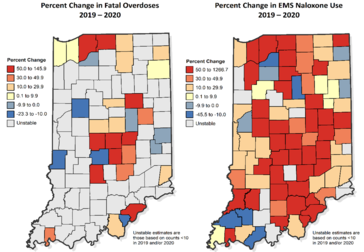 In a special emphasis report released by the Indiana Department of Health, a drug overdose prevention epidemiologist examined the relationship between overdose trends during the COVID-19 pandemic. From January to December 2020, there was a 41% increase in drug overdose deaths in Indiana compared to 2019 during the same period. A 66% increase was seen for EMS Naloxone administration in Indiana during that time. Central Indiana had more significant increases in overdose deaths compared to other regions. Although the counties with high rates of overdose death also had higher cases of COVID-19 there was no positive correlation between them.
Click here to view the full report and see visual data per county in Indiana.
Tufts University School of Medicine collaborated with EMS and academic partners to create a geographic distribution of opioid-related deaths in Massachusetts. Data reports of publicly discarded syringes, opioid-related incidents and fatal opioid deaths were studied to develop the Lowell, Massachusetts, environmental data. Epidemiologist Thomas J. Stopka sought to utilize all relevant available data to target and better understand the opioid epidemic.
The Tufts research team used geographic information systems (GIS) to create descriptive maps, heat maps, and cluster analyses to highlight areas with the highest concentrations of discarded syringes and fatal overdoses, assess change over time and identify significant hotspot clusters.
The authors suggest that to inform local public health intervention efforts communities use spatial epidemiological analyses to enable assessment of risk landscape and trend analyses in the identification of overlapping patterns. Mapping data analyses can inform targeted response efforts, guiding decision-makers to allocate the most needed public health and clinical resources to the neighborhoods that need them most.
The Office of Women's Health at the Indiana Department of Health has been awarded funding to address COVID-19 health disparities among populations at high-risk and underserved, including racial and ethnic minority populations and rural communities. The SANE program can provide services to any victim of crime or violence. The isolation and lockdowns during the COVID-19 pandemic have increased the risk and prevalence of violent crimes, sexual assault, domestic and intimate partner violence, and child sexual and physical abuse.
Throughout Indiana, SANE programs are primarily housed in hospital emergency departments and occasionally established in community-based sexual assault treatment centers. Indiana has 39 counties with one or more facilities that offer medical forensic services, and 17 counties have pediatric SANE programs that provide medical forensic services to prepubescent children.
Applications may be submitted by local health departments, primary care clinics, pediatric clinics, federally-qualified healthcare centers (FQHCs), AIDS service organizations, child advocacy centers, student health centers, urgent cares and walk-in clinics.
The applicant should write an abstract to summarize the proposed project, including the primary activities, deliverables, the community and population to be served, and who will benefit from the proposed project.
For more information about this opportunity and the application process, click here.
|